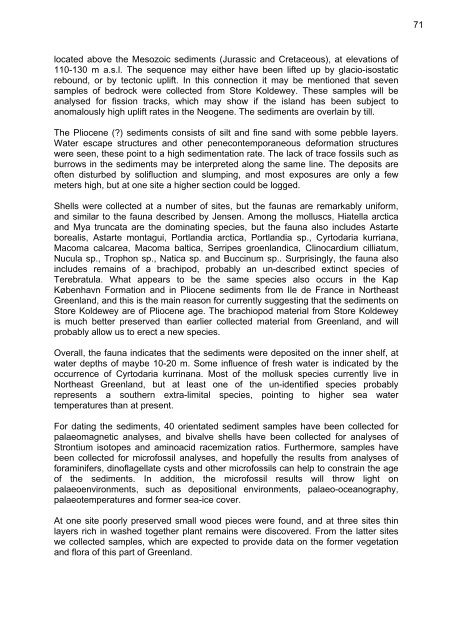the Expedition ARKTIS-XIX/4 of the research vessel POLARSTERN ...
the Expedition ARKTIS-XIX/4 of the research vessel POLARSTERN ...
the Expedition ARKTIS-XIX/4 of the research vessel POLARSTERN ...
Create successful ePaper yourself
Turn your PDF publications into a flip-book with our unique Google optimized e-Paper software.
located above <strong>the</strong> Mesozoic sediments (Jurassic and Cretaceous), at elevations <strong>of</strong><br />
110-130 m a.s.l. The sequence may ei<strong>the</strong>r have been lifted up by glacio-isostatic<br />
rebound, or by tectonic uplift. In this connection it may be mentioned that seven<br />
samples <strong>of</strong> bedrock were collected from Store Koldewey. These samples will be<br />
analysed for fission tracks, which may show if <strong>the</strong> island has been subject to<br />
anomalously high uplift rates in <strong>the</strong> Neogene. The sediments are overlain by till.<br />
The Pliocene (?) sediments consists <strong>of</strong> silt and fine sand with some pebble layers.<br />
Water escape structures and o<strong>the</strong>r penecontemporaneous deformation structures<br />
were seen, <strong>the</strong>se point to a high sedimentation rate. The lack <strong>of</strong> trace fossils such as<br />
burrows in <strong>the</strong> sediments may be interpreted along <strong>the</strong> same line. The deposits are<br />
<strong>of</strong>ten disturbed by solifluction and slumping, and most exposures are only a few<br />
meters high, but at one site a higher section could be logged.<br />
Shells were collected at a number <strong>of</strong> sites, but <strong>the</strong> faunas are remarkably uniform,<br />
and similar to <strong>the</strong> fauna described by Jensen. Among <strong>the</strong> molluscs, Hiatella arctica<br />
and Mya truncata are <strong>the</strong> dominating species, but <strong>the</strong> fauna also includes Astarte<br />
borealis, Astarte montagui, Portlandia arctica, Portlandia sp., Cyrtodaria kurriana,<br />
Macoma calcarea, Macoma baltica, Serripes groenlandica, Clinocardium cilliatum,<br />
Nucula sp., Trophon sp., Natica sp. and Buccinum sp.. Surprisingly, <strong>the</strong> fauna also<br />
includes remains <strong>of</strong> a brachipod, probably an un-described extinct species <strong>of</strong><br />
Terebratula. What appears to be <strong>the</strong> same species also occurs in <strong>the</strong> Kap<br />
København Formation and in Pliocene sediments from Ile de France in Nor<strong>the</strong>ast<br />
Greenland, and this is <strong>the</strong> main reason for currently suggesting that <strong>the</strong> sediments on<br />
Store Koldewey are <strong>of</strong> Pliocene age. The brachiopod material from Store Koldewey<br />
is much better preserved than earlier collected material from Greenland, and will<br />
probably allow us to erect a new species.<br />
Overall, <strong>the</strong> fauna indicates that <strong>the</strong> sediments were deposited on <strong>the</strong> inner shelf, at<br />
water depths <strong>of</strong> maybe 10-20 m. Some influence <strong>of</strong> fresh water is indicated by <strong>the</strong><br />
occurrence <strong>of</strong> Cyrtodaria kurrinana. Most <strong>of</strong> <strong>the</strong> mollusk species currently live in<br />
Nor<strong>the</strong>ast Greenland, but at least one <strong>of</strong> <strong>the</strong> un-identified species probably<br />
represents a sou<strong>the</strong>rn extra-limital species, pointing to higher sea water<br />
temperatures than at present.<br />
For dating <strong>the</strong> sediments, 40 orientated sediment samples have been collected for<br />
palaeomagnetic analyses, and bivalve shells have been collected for analyses <strong>of</strong><br />
Strontium isotopes and aminoacid racemization ratios. Fur<strong>the</strong>rmore, samples have<br />
been collected for micr<strong>of</strong>ossil analyses, and hopefully <strong>the</strong> results from analyses <strong>of</strong><br />
foraminifers, din<strong>of</strong>lagellate cysts and o<strong>the</strong>r micr<strong>of</strong>ossils can help to constrain <strong>the</strong> age<br />
<strong>of</strong> <strong>the</strong> sediments. In addition, <strong>the</strong> micr<strong>of</strong>ossil results will throw light on<br />
palaeoenvironments, such as depositional environments, palaeo-oceanography,<br />
palaeotemperatures and former sea-ice cover.<br />
At one site poorly preserved small wood pieces were found, and at three sites thin<br />
layers rich in washed toge<strong>the</strong>r plant remains were discovered. From <strong>the</strong> latter sites<br />
we collected samples, which are expected to provide data on <strong>the</strong> former vegetation<br />
and flora <strong>of</strong> this part <strong>of</strong> Greenland.<br />
71

















